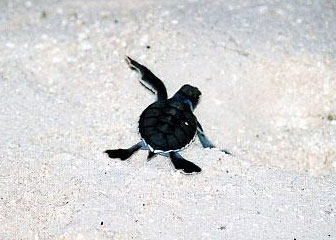Fines on bycatch could help make conservation groups, industry accountable
Fines on bycatch could help make conservation groups, industry accountable
mongabay.com
July 18, 2007
Assessing fines on illegal bycatch could help clean up the fishing industry, reports a new study published in the August issue of Frontiers in Ecology and the Environment.
Each year longlines accidentally catch large numbers of seabirds, turtles, and other species, put them at risk. New research suggests that this source of mortality could also be a source of funding to address other causes of species decline, including pollution and invasive predators.
Authors Josh Donlan of Cornell University and Chris Wilcox of Australia’s Commonwealth Scientific and Industrial Research Organization say that the approach “would give fishermen financial incentives to find creative ways to avoid catching noncommercial species, known as by-catch, while providing funds to address more hazardous threats to seabirds and turtles.”
“Fisheries are complex, revenue-generating industries, and large majorities are unregulated,” said Donlan, a graduate student in ecology and evolutionary biology at Cornell. “Once you add in the cost of doing conservation, this is a win-win situation for a lot of endangered seabirds and sea turtles that are impacted by fisheries’ by-catch.”

Hatchling sea turtle. Photo by N. Butler |
The authors’ conclusions are based on analysis of Australia’s Eastern Tuna and Billfish Fishery, a fishery that targets albacore, yellowfin and bigeye tuna and billfish, but accidentally kills 1,800 to 4,500 flesh-footed shearwaters (Puffinus carneipus), a threatened seabird with a breeding range restricted to Lord Howe Island.
“The researchers compared the expected costs and conservation benefits of closing down fishing areas that suffer from other causes of population decline, such as rats eating eggs, chicks and adult birds on the island,” explained a news release from Cornell University. “Their analysis showed that closing the fishery around Lord Howe Island would cost about $3 million U.S. and increase the growth rate of the shearwater population by about 6 percent. But killing the rats would cost only about $500,000, yet yield a 32 percent increase in shearwater population growth. In other words, killing the rats would increase the shearwater population per dollar invested 23 times more than closing the fishery. ”
The researchers say the system would help make both industry and conservation groups more accountable.
“Levies, with higher fees imposed for more endangered species, would make users who earn a profit from common-pool resources pay for the impacts they have on the system,” continued the Cornell statement. “At the same time, they argue, if levy money were given to conservationists to address other threats to seabird or turtle populations, then these conservationists would in turn be made more accountable for producing and quantifying results.”
“This idea moves away from strictly charity models of doing conservation [where money is donated to conservationists], to a noncharity model [where those involved are held accountable],” said Donlan.







